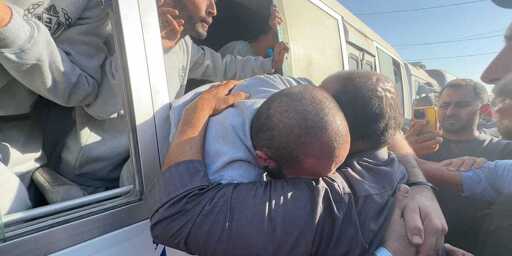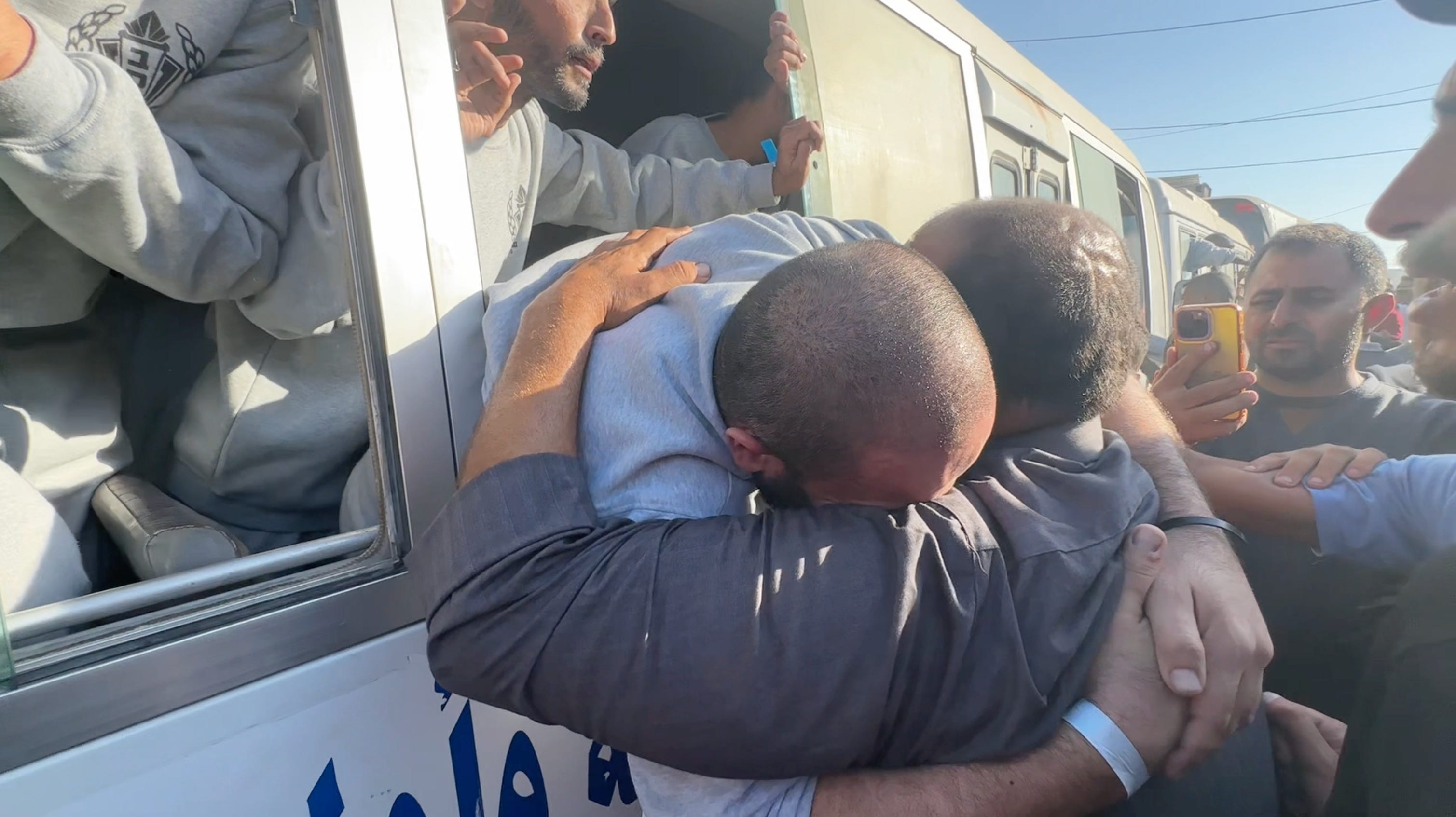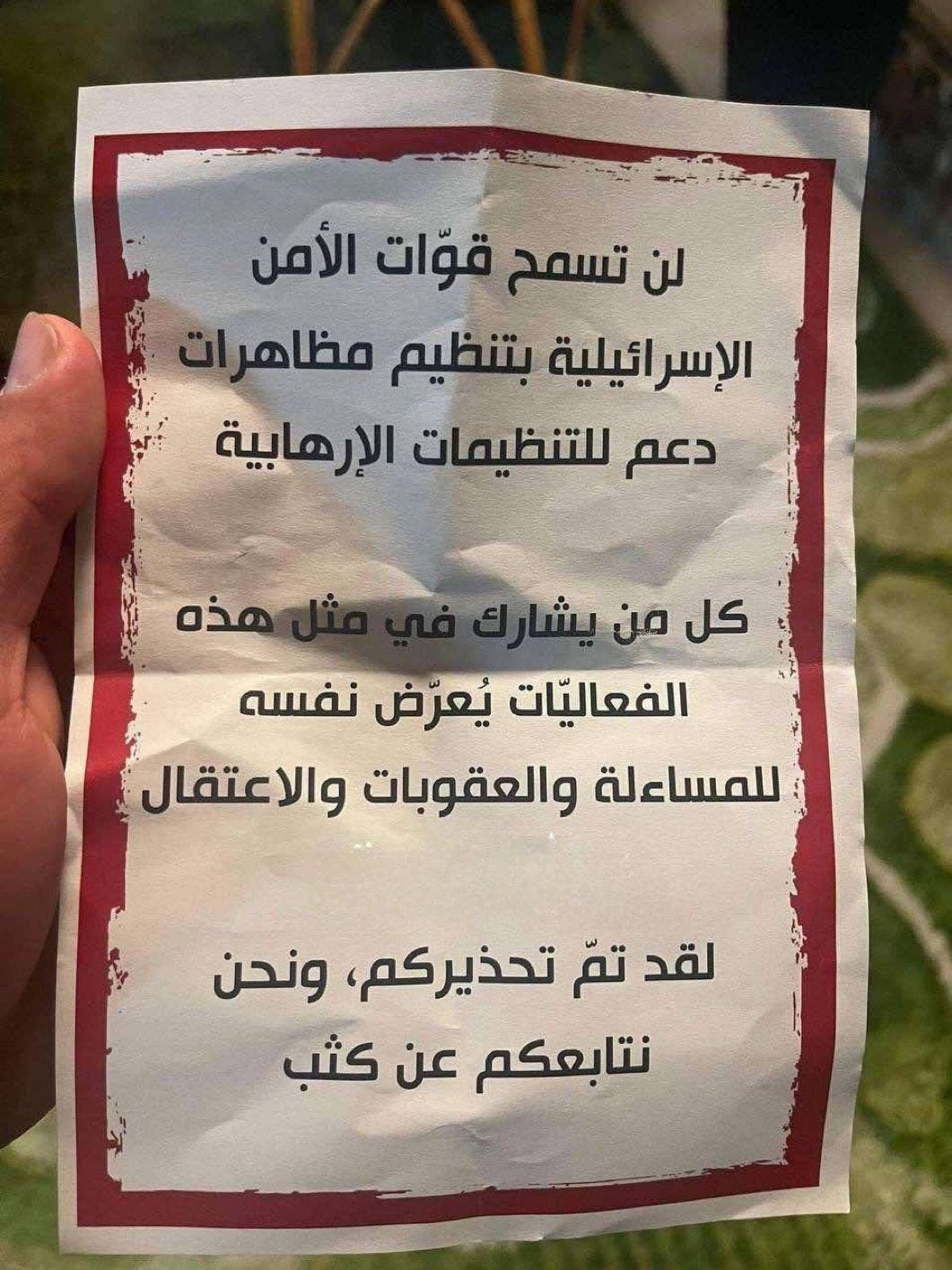We have a commitment to ensuring that our journalism is not locked behind a paywall. But the only way we can sustain this is through the voluntary support of our community of readers. If you are a free subscriber and you support our work, please consider upgrading to a paid subscription or gifting one to a friend or family member. You can also make a 501©(3) tax-deductible donation to support our work. If you do not have the means to support our work financially, you can do your part by sharing our work on social media and by forwarding this email to your network of contacts.
Freed Palestinian captive Muhammad Nasr hugs a friend after arriving in a bus to Nasser Hospital in Khan Younis, Gaza Strip on October 13, 2025, as part of the ceasefire agreement.
KHAN YOUNIS, GAZA STRIP—Hundreds of Palestinian captives released from Israeli detention arrived to cheering crowds gathered outside Nasser Hospital in Khan Younis on Monday as part of the Gaza ceasefire agreement, which went into effect on Friday. The deal saw the release of nearly 2,000 Palestinians imprisoned in Israeli prisons and detention centers along with the release of all 20 living Israeli captives held in Gaza.
A total of 1,986 Palestinian prisoners were scheduled to be released on Monday, including 1,718 detained from Gaza by Israel after October 7, 2023, according to the Palestinian Prisoners’ Media Office, and 250 Palestinian prisoners serving long-term or life sentences. Of those 250, 154 were exiled to Egypt, 88 released in the occupied West Bank and Jerusalem, and eight released in Gaza.
In Khan Younis, thousands of people gathered to greet the freed detainees, who arrived in dozens of buses operated by the Red Cross and in Red Crescent ambulances. The crowds gathered in the courtyard of Nasser Hospital and on rooftops and balconies overlooking the medical complex where the freed captives were taken for medical checks. Nasser hospital, which has been repeatedly bombed by the Israeli military, is one of only 13 out of 38 hospitals still partially functioning in Gaza.
Freed detainees wearing gray jumpsuits leaned out of bus windows and waved to the crowds. Family members and friends embraced them through the windows as they drove by.
Freed Palestinian captives arrive at Nasser Hospital in Khan Younis on October 13, 2025. (Video by Abdel Qader Sabbah.)
“Praise be to God, who honored us with reaching Gaza, so we can breathe its pure soil, soaked with the blood of the martyrs, the brave wounded, and its patient and steadfast people,” Mahmoud Fayez Abu Al-Kas, a freed Palestinian captive told Drop Site through a bus window. “My message to the people of Gaza: Do not lose hope, do not despair of God’s mercy, and God willing, He will reward us with something better and honor us.”
Another freed captive Palestinian, Muhammad Nasr from Jabaliya Al-Nazla, told Drop Site, “It’s a sad feeling, but thank God, we are happy that you all are safe—that the country still has good young people, and that there are still children in good health,” he said, adding, “All this destruction, by God’s will, will be rebuilt, and the country will return even better than before. And God willing, all the detainees will be released. All the detainees are our brothers, they are all our family.”
People in the crowds repeatedly asked the freed captives if they had seen their loved ones, still missing in detention. Families often had no idea if their relatives had been detained, and it often took months to determine if they were in Israeli custody, if confirmation came at all.
“I felt a sense of breath, a relief, and I was so relieved when I heard my brother’s name,” said a Palestinian man in Khan Younis who did not give his name but said his brother was included on the list of freed detainees. “He has been imprisoned for two years, not knowing which prison he was in even though we communicated with people to find out who had been released from prisons, in hopes of knowing whether he was alive or dead,” he added, holding back tears. “[God] returned my brother to me safe and sound, even though my father himself wanted to see him, and last week, he was martyred. He wanted to see him. It wasn’t his fate to see him.”
Palestinian prisoner rights groups say an unknown number of Palestinians from Gaza remain in Israeli custody, though the Israeli human rights group Hamoked puts the figure at around 1,300, including doctors, journalists, and emergency rescue workers.
“As Civil Defense teams, we have detainees in the occupation’s prisons,” Muhammad Tamouz, a member of the Civil Defense Directorate, told Drop Site earlier in the day as he waited for the freed detainees to arrive at Nasser. “Today, we came to receive them—eight detainees are being released…the fate of others remains unknown until now.”
Among those included on the list of Palestinians prisoners to be released is Dr. Hossam Abu Safiya, the director of the Kamal Adwan Hospital in Beit Lahia, according to Haaretz. Abu Safiya was detained along with several of his colleagues when the Israeli military raided the hospital in December 2024. Israeli authorities reportedly added Abu Safiya’s name and four others to the list of approved releases overnight, though a statement from his family on Monday indicated he has not yet been freed.
Palestinian detainees, rights groups, and the United Nations have reported on systematic abuse in Israeli detention facilities, including routine beatings, starvation, isolation, medical neglect, and sexual assault.
“We died a thousand times each day,” a Palestinian photojournalist from Gaza, Shadi Abu Sido, said in an interview on Al-Mayadeen TV on Monday following his release from nearly 20 months in Israeli detention. “We didn’t know the time or the date. We didn’t know the taste of sleep or the taste of food. They would come in the middle of the night and throw water on us in the cells. The would come and torture us in every way.” He added, “I want nothing other than they release all the prisoners,” he said. “They all need to be freed so they can be done with this suffering.”
Before Monday’s releases, over 11,100 Palestinians from Gaza, Jerusalem, and the West Bank were being held in Israeli detention, the majority of them being held without trial or charge in administrative detention or as “unlawful combatants.” The figure does not include the number of Palestinians, mostly from Gaza, held in Israeli military camps.
Earlier in the day, the 20 living Israeli captives were handed over and driven outside of Gaza by the Red Cross through the Kissufim crossing. Some Palestinians filmed them on their phones as they drove by.
Freed Israeli captives are escorted out of Gaza by the Red Cross on October 13, 2025. (Video by Abdel Qader Sabbah.)
Hamas announced on Monday that it would release the bodies of four dead Israeli captives by the end of the day. The remaining two dozen dead captives are also expected to be handed over as part of the deal, although the exact timing remains unclear. At least 77 Palestinians have died in Israeli custody over the past two years, according to the Palestinian Prisoner’s Society and the prisoner rights group, Addameer—46 of them among those detained from Gaza. Israeli authorities continue to withhold the bodies of 85 prisoners killed in detention, including 74 who died since the start of the war.
In the occupied West Bank, buses carrying freed Palestinian captives arrived in Beitunia, near Ramallah, where hundreds of families and supporters awaited them, according to Palestinian media reports. The Israeli military fired tear gas and rubber bullets at the crowd. Israel warned Palestinians in the West Bank against celebrating the releases—as has happened in the past. Israeli forces distributed fliers saying that “anyone who participates in such activities exposes himself to punishment and arrest.”
Israel distributed flyers in the occupied West Bank warning Palestinians not to celebrate the release of Palestinian captives. October 12, 2025. (Source: Palestinian Center for Prisoners Advocacy.)
As the prison exchange was taking place on Monday, President Donald Trump arrived in Israel and addressed the Knesset, Israel’s parliament, where Israeli lawmakers chanted Trump’s name and gave him repeated standing ovations. He told Israeli lawmakers, “You’ve won. I mean, you’ve won,” adding, “Now it is time to translate these victories against terrorists on the battlefield into the ultimate prize of peace and prosperity for the entire Middle East.”
Trump then traveled to Egypt where he attended a summit co-hosted by Egypt and the U.S. in Sharm El-Sheikh and attended by leaders from nearly 30 countries. While a deal was reached on “phase one” of a ceasefire that included the exchange of captives, a partial Israeli withdrawal, and aid being allowed into Gaza, details of how the plan will advance beyond that remain murky. Now that Hamas and other Palestinian resistance factions have handed over all living Israeli captives, there are widespread fears that Israel will resume its scorched earth genocidal assault. Hamas has only received verbal assurances from the U.S. and mediators that the agreement will hold beyond that.
Trump was asked by reporters in Sharm el-Sheikh about when the second phase of the negotiations was going to begin. “It’s started, as far as we are concerned,” he said during his meeting with Egyptian president Abdel Fattah Al-Sisi. After signing a document on the ceasefire deal, Trump said, “It’s going to hold up.”
Drop Site News Middle East Research Fellow Jawa Ahmad contributed to this report.
From Drop Site News via this RSS feed




